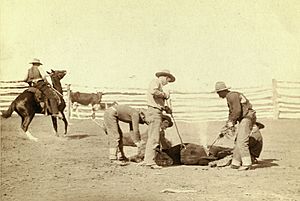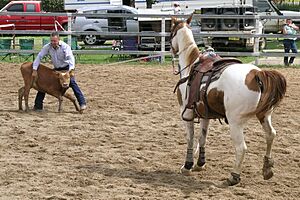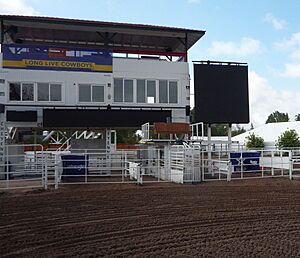Calf roping facts for kids
Calf roping, also called tie-down roping in the United States and Canada, is an exciting rodeo event. It involves a calf and a rider on a horse. The main goal is for the rider to quickly catch the calf with a rope, get off their horse, run to the calf, and gently tie three of its legs together. The fastest time wins! There's also a similar sport called breakaway roping where the calf is roped but not tied.
Contents
How Calf Roping Started

Calf roping began from the real work of cowboys on ranches. Cowboys often needed to catch and hold calves for things like branding or giving them medicine. Ranch workers became very good at roping and tying calves quickly. Soon, this everyday work turned into fun, informal contests among them.
How the Modern Event Works
Getting Ready to Rope
Calves are kept in a line and moved into a narrow chute with special doors. When a calf is in place, a door closes behind it. A light rope, about 28 feet (8.5 meters) long, is put around the calf's neck. This rope is connected to a trip lever. The lever holds a "barrier" cord that stretches across a large pen where the horse and rider wait. This barrier gives the calf a head start.
Starting the Clock
When the roper is ready, they call for the calf. The chute operator then opens the doors, letting the calf run out straight. As the calf reaches the end of its rope, it trips the lever. The rope falls off the calf, and the barrier for the horse drops. This action starts the clock, allowing the horse and rider to chase the calf.
The Chase and the Rope
Timing is super important! The rider makes their horse start galloping from the pen right after the calf leaves the chute. This helps them gain speed quickly. However, if the horse starts too soon and breaks the barrier before it's released, the rider gets a 10-second penalty. This is sometimes called a "Cowboy Speeding Ticket."
The rider must throw a loop of their lariat (rope) around the calf's neck while still on horseback. Once the rope is on the calf, the roper signals the horse to stop fast. The roper then quickly gets off the horse and runs to the calf. The calf must be stopped by the rope but should not be pulled to the ground. If it falls, the roper loses time because they have to let the calf stand up again.
Tying the Calf
When the roper reaches the calf, they gently pick it up and flip it onto its side. Then, they use a short rope called a "piggin' string" to tie three of the calf's legs together. A special knot, sometimes called "two wraps and a hooey," is used. The roper often holds the piggin' string in their teeth until they need it. The horse is trained to help by slowly backing away from the calf. This keeps the rope tight.

Finishing the Event
Once the tie is complete, the roper throws their hands in the air to signal "time" and stop the clock. The roper then gets back on their horse and moves it forward to loosen the rope. An official waits for six seconds to make sure the calf stays tied. If it does, the time is officially recorded. After six seconds, two officials untie the calf and let it leave the arena. The best professional calf ropers can rope and tie a calf in about seven seconds. The world record is just over six seconds!
Rules and Organizations
Calf roping is a recognized event by many rodeo groups. These include the Professional Rodeo Cowboys Association (PRCA) and the International Professional Rodeo Association (IPRA). In the United States, there are also groups just for calf roping, like the National Calf Ropers Association (NCRA). Other rodeo events that use cattle include breakaway roping, steer wrestling, and team roping.
In PRCA events, calves must weigh between 220 and 280 pounds (about 100 to 127 kg). They must be strong and healthy. Sick or injured calves cannot be used. The PRCA states that most calves are only used a few dozen times because they grow so fast and there are rules about how often they can compete.
Animal Care in Rodeo
People sometimes worry about the well-being of calves in professional rodeo. However, the rodeo industry has strict rules and watches events closely. Competitors are penalized if they "jerk down" a calf too hard or flip it over backward.
Studies have shown that injuries to animals in rodeos are very rare. For example, a 1994 study looked at over 33,000 animal runs at 28 rodeos. It found that the injury rate was less than five-hundredths of one percent (0.047%). Another study in Australia found a similar low injury rate. A later PRCA survey of over 60,000 animal performances also showed an injury rate of about five-hundredths of one percent.
Some animal rights groups argue that injuries can happen, such as broken bones. Because of these concerns, tie-down calf roping is not allowed in some places. This includes the state of Rhode Island and the city of Baltimore in the US. It's also banned in some areas of Australia, Brazil, and Canada, and nationally in the United Kingdom, Germany, and The Netherlands.
The ASPCA, an animal welfare organization, notes that practice sessions might sometimes have more issues than actual competitions. A 2016 study suggested that the process of calf roping can be stressful for the animals. However, the stress did not last long. Researchers thought that experienced ropers might cause less stress to the animals than new ropers.
See also



